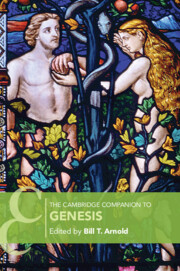Book contents
- The Cambridge Companion to Genesis
- Cambridge Companions to Religion
- The Cambridge Companion to Genesis
- Copyright page
- Contents
- Abbreviations
- Contributors
- 1 Introduction: Genesis and the status quaestionis
- Part I Composition and Structure of Genesis
- 2 Genesis in the History of Critical Scholarship
- 3 Genesis in Source and Redaction Criticism Today
- 4 Genesis in Form and Tradition Criticism Today
- 5 Rhetorical Features and Characteristics:
- Part II Social World of Genesis
- Part III Themes and Literary Motifs of Genesis
- Part IV Reception History of Genesis
- Scripture Index
- Subject Index
- Cambridge Companions to Religion (continued from page iii)
- References
5 - Rhetorical Features and Characteristics:
The Literary Function of Genealogies, Itineraries, and Other Etiologies in the Book of Genesis
from Part I - Composition and Structure of Genesis
Published online by Cambridge University Press: 02 June 2022
- The Cambridge Companion to Genesis
- Cambridge Companions to Religion
- The Cambridge Companion to Genesis
- Copyright page
- Contents
- Abbreviations
- Contributors
- 1 Introduction: Genesis and the status quaestionis
- Part I Composition and Structure of Genesis
- 2 Genesis in the History of Critical Scholarship
- 3 Genesis in Source and Redaction Criticism Today
- 4 Genesis in Form and Tradition Criticism Today
- 5 Rhetorical Features and Characteristics:
- Part II Social World of Genesis
- Part III Themes and Literary Motifs of Genesis
- Part IV Reception History of Genesis
- Scripture Index
- Subject Index
- Cambridge Companions to Religion (continued from page iii)
- References
Summary
The study of the rhetorical features and characteristics in Genesis was started by Hermann Gunkel at the beginning of the twentieth century.1 He demonstrated how the narratives originated in the folklore of Israelite and pre-Israelite cultures, and how they were transformed into larger collections and finally into the literary documents which formed the book of Genesis. Although today few believe we can illuminate the history of pre-literary traditions and identify any orally based subunits of minor literature (Kleinliteratur) according to their initial setting of genre (Sitz im Leben), we can focus on the setting of the primary readership of the final written form.2 In addition, Gunkel’s observations on formal criteria and comparisons with other ancient Near Eastern literature are still a valuable foundation for contemporary exegesis.
- Type
- Chapter
- Information
- The Cambridge Companion to Genesis , pp. 99 - 118Publisher: Cambridge University PressPrint publication year: 2022



